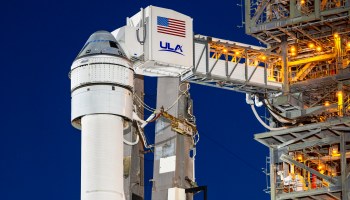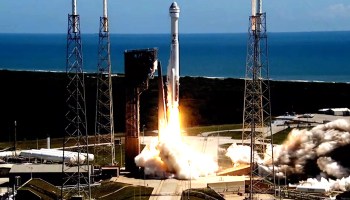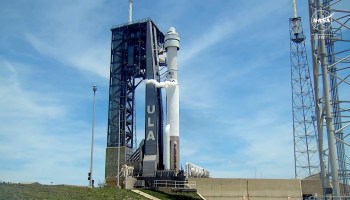
Boeing’s Starliner capsule and its two-person NASA crew arrived at the International Space Station today after mission managers coped with some post-launch glitches involving the spacecraft’s propulsion system.
“Today’s docking, I think, was challenging,” Steve Stich, program manager for NASA’s Commercial Crew Program, told reporters after Starliner’s arrival. “We had a few things we had to work through as a team.”
One of the glitches had to do with the thrusters that are used to maneuver the gumdrop-shaped capsule in orbit. Five of the 28 thrusters initially malfunctioned — which forced NASA astronauts Butch Wilmore and Sunita Williams to put their final approach to the station on hold for more than an hour.
Four of the balky thrusters were successfully reactivated, clearing the way for the docking procedure to resume.
Other glitches cropped up in Starliner’s helium pressurization system: Even before Wednesday’s milestone launch — which set the first crewed Starliner flight in motion — engineers at NASA and Boeing knew there was a helium leak in the propulsion system and decided to live with it. But after launch, three more leaks were detected.
The mission team determined that there would still be enough reserves to carry on safely. “Just at the top level, we should have absolutely plenty of margin,” Stich said.
Wilmore and Williams have both been to the station twice before, but this was the first time anyone ever arrived on a Starliner capsule.
“Nice to be attached to the big city in the sky,” Wilmore said when docking was complete. “We’re looking forward to staying here for a couple of weeks, and getting all the things done on Starliner that we need to get done — and also on station.”
After all the leak checks, Starliner’s spacefliers floated through the hatch to meet up with the space station’s crew and exchange a round of enthusiastic hugs.
“We are very happy,” Russian cosmonaut Oleg Kononenko, the station’s current commander, told the new arrivals.
“We are thrilled as well,” replied Wilmore, the Starliner test mission’s commander. “We’re ready to go to work for the international partners here. Whatever it is you’ve got for us to do, we’re ready.”
During their orbital stay, Wilmore and Williams will help out with the delivery of about 800 pounds of cargo, including a replacement pump for the station’s urine-recycling system. They’ll also continue checkouts of Starliner’s systems. The earliest scheduled date for their return to Earth is June 14. (Update: NASA is extending Starliner’s stay at the space station to June 25 at the earliest, to provide more time for troubleshooting the thruster malfunctions and the helium leaks.)
After the mission’s end, NASA and Boeing will assess issues of concern — no doubt including the propulsion system glitches — and determine what else needs to be done to certify Starliner for regular crewed trips to the space station.
Boeing has already encountered years of delays and roughly $1.5 billion in cost overruns due to technical setbacks in the Starliner program. SpaceX’s Crew Dragon was certified to carry astronauts back in 2020 and has become NASA’s mainstay for crew transportation, but NASA says it’s important to have more than one commercial provider.



